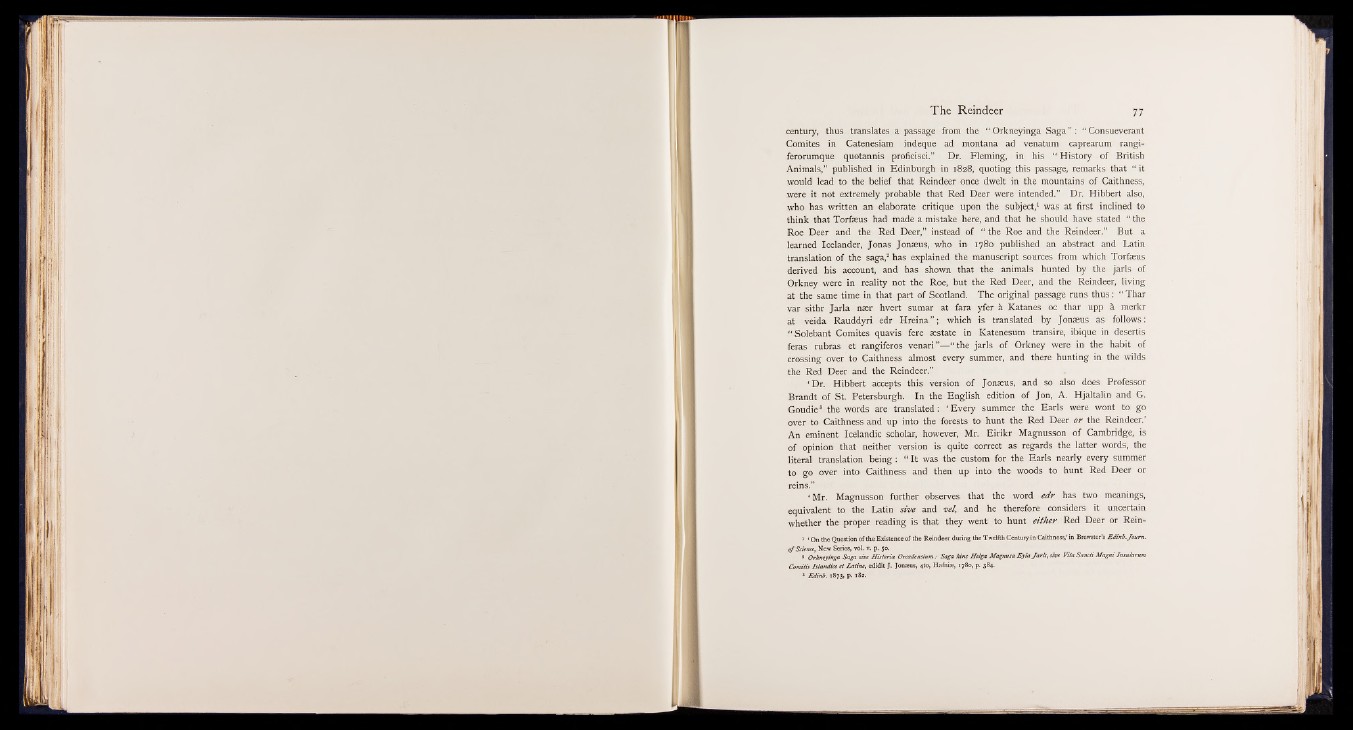
century, thus translates a passage from the “ Orkneyinga Saga” : “ Consueverant
Comités in Catenesiam indeque ad montana ad venatum caprearum rangi-
ferorumque quotannis proficisci.” Dr. Fleming, in his “ History of British
Animals,” published in Edinburgh in 1828, quoting this passage, remarks that “ it
would lead to the belief that Reindeer once dwelt in the mountains of Caithness,
were it not extremely probable that Red Deer were intended.” Dr. Hibbert also,
who has written an elaborate critique upon the subject,1 was at first inclined to
think that Torfæus had made a mistake here, and that he should have stated “ the
Roe Deer and the Red Deer,” instead of “ the Roe and the Reindeer.” But a
learned Icelander, Jonas Jonæus, who in 1780 published an abstract and Latin
translation of the saga,2 has explained the manuscript sources from which Torfæus
derived his account, and has shown that the animals hunted by the jarls of
Orkney were in reality not the Roe, but the Red Deer, and the Reindeer, living
at the same time in that part of Scotland. The original passage runs thus : “ Thar
var sithr Jarla nær hvert sumar at fara yfer à Katanes oc thar upp à merkr
at veida Rauddyri edr Hreina” ; which is translated by Jonæus as follows:
“ Solebant Comités quavis fere æstate in Katenesum transire, ibique in desertis
feras rubras et rangiferos venari”— “ the jarls of Orkney were in the habit of
crossing over to Caithness almost every summer, and there hunting in the wilds
the Red Deer and the Reindeer.”
‘ Dr. Hibbert accepts this version of Jonæus, and so also does Professor
Brandt of St. Petersburgh. In the English edition of Jon, A. Hjaltalin and G.
Goudie8 the words are translated: ‘ Every summer the Earls were wont to go
over to Caithness and up into the forests to hunt the Red Deer or the Reindeer.’
An eminent Icelandic scholar, however, Mr. Eirikr Magnusson of Cambridge, is
of opinion that neither version is quite correct as regards the latter words, the
literal translation being: “ It was the custom for the Earls nearly every summer
to go over into Caithness and then up into the woods to hunt Red Deer or
reins.”
‘ Mr. Magnusson further observes that the word edr has two meanings,
equivalent to the Latin sive and vel, and he therefore considers it uncertain
whether the proper reading is that they went to hunt either Red Deer or Rein-
1 ‘ On the Question of the Existence of the Reindeer during the Twelfth Century in Caithness,’ in Brewster’s Edinb.Joum.
o f Science, New Series, vol. v. p. 50.
s Orkneyinga Saga sive Historia Orcadensium: Saga kins Helga Magnusa Eyia Jarls, sive VitaSancti Magni Insularum
Comitis Islandice et Latine, edidit J. Jonæus, 4to, Hafniæ, 1780, p. 384.
* Edinb. 1873, p. 182.